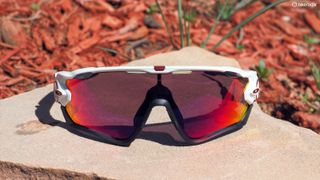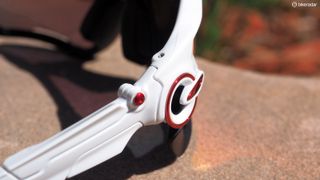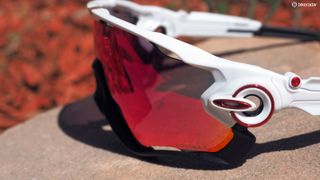New Oakley Jawbreaker sunglasses break ground
Radical design developed with Manx sprinter Mark Cavendish













This article originally appeared on BikeRadar
Oakley today debuted its brand-new Jawbreaker sunglasses – designed in cooperation with superstar sprinter Mark Cavendish and arguably the company's most audacious eyewear design in over a decade. Jawbreaker is notably bigger than the Radarlock XL, its aesthetic is more polarizing than the Hincapie-era Racing Jackets, and the mechanical Switchlock gadgetry of the current Jawbone gets turned up a few notches to yield a set of decidedly over-the-top shades that's sure to generate some heated discussion.
First and foremost, the new Jawbreaker lens is big. The width is roughly the same as the already-generous Radarlock XL but instead of dipping down in middle, the top of the lens now features an upward curve to provide a bigger field of view, particularly when riding in a low and aggressive position. The lower edge is now scalloped to provide a little more room around your cheeks but even so, the only way these look even remotely normal is when paired with a helmet.

The new Oakley Jawbreakers look massive on their own but they're actually quite agreeable when paired with a helmet
"For the cyclist it's always been a tradeoff [to] get field of view and maximum protection but sacrifice ventilation," said Oakley concept development director Ryan Calilung. "The size is intentional to give the user all three – an increased upward field of view with ventilation and protection. This is important for the 'eyes-up/head-down' body position for cycling. Jawbreaker has a level of vision and protection without compromise, beyond what the consumer has seen before. It's a statement piece with real performance benefits."
While the Jawbreaker's looks are unquestionably polarizing, they're to a large extent dictated by the design's dizzying array of moving parts and gadgets. In fact, 27 separate pieces go into just one pair of glasses.

Each pair of Jawbreakers requires 27 separate parts
Get The Leadout Newsletter
The latest race content, interviews, features, reviews and expert buying guides, direct to your inbox!
Much like the Jawbone, the Jawbreaker features a hinged lower frame to lock the lens in place. Jawbreaker uses a huge single shield instead of separate dual lenses, however, and there's now a metal cam device built into the nosepiece instead of snap-together plastic bits. This not only makes for a more secure fit but also lends the Jawbreaker a notably sturdier overall feel.
Out back, Oakley has also incorporated into Jawbreaker rubber-covered earpieces that can be adjusted in three different lengths to better fit a wider range of rider head shapes and helmet retention systems.

The new Jawbreakers feature the latest incarnation of Oakley's 'Switchlock' technology
"We didn't set out to make 27 parts," Calilung continued. "Instead, we started with a long list of problems. The magic of Jawbreaker is how all of the performance solutions live together without compromise. Jawbreaker has several benefits that have never been wrapped up in one piece of eyewear before and those solutions drove the complexity."
Despite all of that hardware, the new Jawbreakers don't feel particularly cumbersome on your face and they still hit the scales at a surprisingly reasonable 34g – just a single gram heavier than the Radarlock XL but a noticeable 8g heavier than Smith Optics' much simpler Pivlock Arena Max.
That said, there's no arguing with the quality of the optics, which is unquestionably superb. As intended, the field of view is expansive with almost none of the frame visible except when peering downward. There's also no noticeable distortion and, despite the expansive coverage, fogging hasn't been much of an issue given the venting around the edges – at least given our minimal riding time so far.

As we've come to expect from Oakley, optical quality is absolutely superb
However, we do still wish that Oakley would revert back to the early days of its hydrophobic lens coating when it was applied to both sides. As it is currently, it works very well at sloughing off road spray and mud but since it's only applied to the outer lens surface, it does nothing for sweat dripping off of your forehead (which in our experience, is a much bigger problem). Oakley does offer the coating as a standalone DIY kit but given Jawbreaker's premium pricing, we'd certainly prefer that it come double-sided stock.
Small complaints aside, Jawbreaker is undoubtedly distinctive – like it or not. We've only just started using our test sample so check back for a more complete review in the coming weeks.
Prizm lenses hit the road (and trail)
Our Jawbreaker test sample arrived with Oakley's latest Prizm lens – a new philosophy in lens tinting from Oakley that aims to more specifically highlight desirable hues and shades while also more precisely tuning out unwanted ones.
According to Oakley, the pavement-specific Prizm Road lens boosts road texture, painted lines, and traffic lights while also enhancing greens and blues. Whether this produces the "more pleasant riding experience" that Oakley claims, Prizm does make road hazards stand out more so than usual – and certainly more so than any grey-based lens.

Oakley's new Prizm lens technology admitted sounds like a lot of hype but it honestly does work as intended
The difference is more dramatic with the mountain bike-specific Prizm Trail version, though, which Oakley says is tuned to boost reds and browns while also making plants look more vivid. Especially here in Colorado with its expanses of parched earth, dried-out flora, and blindingly intense sunlight, Prizm Trail can feel a bit too bright but it unquestionably also makes the ground much easier to read – particularly when darting in and out of the shade.
The new Jawbreaker is set to hit shelves around April 15 and will start at US$200 / €199 / AU$280 with one lens. Replacement lenses will arrive in stores May 1 and replacement Prizm lenses will follow on June 1. Prizm lens for most other Oakley models are in stores now and start at US$80. UK pricing is still to be confirmed.
Most Popular


